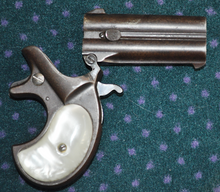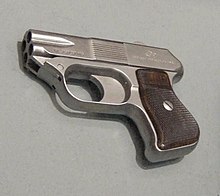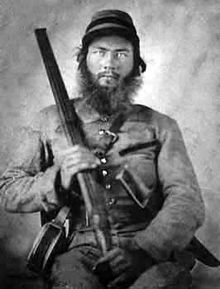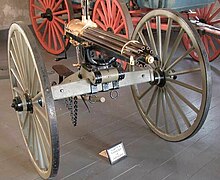Multiple-barrel firearm
This article has multiple issues. Please help improve it or discuss these issues on the talk page. (Learn how and when to remove these template messages)
|
A multiple-barrel firearm is any type of firearm with more than one gun barrel, usually to increase the rate of fire or hit probability and to reduce barrel erosion or overheating.[1]
History
Volley gun

Multiple-barrel firearms date back to the 14th century, when the first primitive volley guns were developed.[2] They are made with several single-shot barrels assembled together for firing a large number of shots, either simultaneously or in quick succession. These firearms were limited in firepower by the number of barrels bundled, and needed to be manually prepared, ignited, and reloaded after each firing.
In practice the large volley guns were not particularly more useful than a cannon firing canister shot or grapeshot. Since they were still mounted on a carriage, they could be as hard to aim and move around as a heavy cannon, and the many barrels took as long (if not longer) to reload.[3] They also tended to be relatively expensive since they were structurally more complex than a cannon, due to all the barrels and ignition fuses, and each barrel had to be individually maintained and cleaned.
Pepperbox
A pepper-box gun or "pepperbox revolver" has three or more barrels revolving around a central axis, and gets the name from its resemblance to the household
In the 15th century, there were design attempts to have several single-shot barrels attached to a stock, being fired individually by means of a match. Around 1790, pepperboxes were built on the basis of flintlock systems, notably by Nock in England and "Segallas" in Belgium. These weapons were built on the success of the earlier two-barrel turnover pistols, which were fitted with three to seven barrels. These early pepperboxes had to be manually rotated by hand.[4]
The invention of the
Derringer


The original
The Sharps Derringers had four-barrels with a revolving firing pin (often called the "Sharps Pepperbox" despite not having a revolving-barrel design) and they were first patented in 1849,[10] but were not manufactured until 1859, when Christian Sharps patented a more practical design. When loading and unloading, the four barrels slide forward to open the breech. Production of these came to an end with the death of Christian Sharps in 1874.
Modern derringer designs are almost all multi-barrelled, most variants have two-barrels or four-barrels, thus essentially makes them a compact and concealable handheld version of the
DoubleTap Defense introduced a double-barreled (over-and-under), double-action hammerless DoubleTap derringer in 2012.[11] The name comes from the double tap shooting technique, in which two consecutive shots are quickly fired at the same target before engaging the next one.[12] These derringers also hold two extra rounds of cartridge in the grip, allegedly drawing inspiration from the FP-45 Liberator pistol.[13]
Double-barrel shotgun

By 1790,
During the 19th century, shotguns were mainly employed by
In 1909,
Double rifle
The development of the double rifle has always followed the development of the double-barrelled shotgun, the two are generally very similar but the stresses of firing a solid projectile are far greater than
These first double-barrelled weapons were
Various experimental
By 1900, the boxlock and sidelock hammerless actions had largely superseded the hammer rifles and, with the addition of ejectors and assisted opening, the basic design of the double rifle has changed little to this day. Incidentally, it was Westley Richards who invented the first reliable safety catch for doubles, ejectors, the single selective trigger and the special extractors that enabled rimless cartridges to be used in double rifles, all features found in modern double rifles.
After the
Rotary gun


The Gatling gun is one of the best-known early rapid-fire weapons and a forerunner of the modern
The Gatling gun's operation centered on a
Richard Gatling later replaced the hand-cranked mechanism of a rifle-caliber Gatling gun with an
During
In the 1960s, the
In order to develop a weapon with a more reliable, higher rate of fire,
The Minigun was mounted on
See also
- Combination gun – Type of firearm with at least one rifled barrel and one smoothbore barrel
- Double-barreled rifle– Sporting rifle with two parallel barrels – Rifle with two parallel barrels
- Double-barreled shotgun – Shotgun with two parallel barrels
- List of multiple-barrel firearms – List of weapons with multiple barrels
- Multiple rocket launcher – Rocket artillery system capable of launching multiple rockets in quick succession
- Small Arms– Gun for an individual – Portable weapons that can be carried and used by an individual person.
References
- ^ Suciu, P. (2020, December 18). The M61 minigun is a gatling gun on steroids. The National Interest. Retrieved October 30, 2021, from https://nationalinterest.org/blog/reboot/m61-minigun-gatling-gun-steroids-174655.
- ^ "HyperWar: The Machine Gun (Vol. /Part )". Ibiblio.org. Retrieved May 15, 2015.
- ^ Matthew Sharpe "Nock's Volley Gun: A Fearful Discharge" American Rifleman December 2012 pp.50-53
- ^ The new weapons of the world encyclopedia: An international encyclopedia from 5000 B.C. to the 21st century by Diagram group, (Macmillan, 2007) p.126
- ^ Cooper, C, Samuel Colt: Arms, Art, and Invention (2006) p.26
- ISBN 0-8032-8903-0.
- ^ "Remington .41 Double Derringer". American Rifleman. March 24, 2014. Retrieved 2017-07-22.
- ISBN 978-1-59228-690-4.
- ISBN 978-0-89689-647-5.
- ISBN 978-0-87349-768-8.
- ^ S., Jeremy (2013-07-01). "Gun Review: DoubleTap Tactical Pocket Pistol". The Truth About Guns. Retrieved 2016-09-05.
- ^ "Frequently Asked Questions". Heizer Defense LLC. Archived from the original on 14 October 2012. Retrieved 22 December 2012.
- ^ "Announcement". Heizer Defense LLC. 7 November 2012. Retrieved 22 December 2012.
- ^ a b Taylor, John M. (2016-05-23). "Looking Back at Shotgun History". American Rifleman. Retrieved 2020-10-27.
- ^ Chambers, John W. (II) (2000). "San Juan Hill, Battle of". The Oxford Companion to American Military History. HighBeam Research Inc. Archived from the original on 2009-11-26. Retrieved 2009-11-24.
- ^ "U.S. Patent 502185 Gatling Gun". Retrieved February 4, 2010.
- ISBN 978-1-4391-9653-3.
- ^ a b Weyl, A. R. (8 March 1957). "Motor-guns—a Flashback to 1914-18". Flight. 71 (2511): 313–314. Retrieved 30 September 2015.
- ^ Williams, Anthony G. (8 November 2005). "Split Breech Guns: The Nutcracker and the 40mm Mk 18". Archived from the original on 14 June 2007.
- ISBN 978-1-86126-655-2.
- ^ "General Electric M134 Minigun Six-Barrel Gatling Gun".
- ^ a b Jarvis, John Paul. "Brought to You By GE: The M134 Minigun". Archived from the original on 2012-02-19. Retrieved 2018-11-21.
